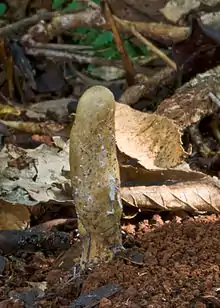Cordyceps gunnii
Cordyceps gunni is a species of fungus in the family Cordycipitaceae, and is of the genus Cordyceps. It was originally found and recorded by Gunn in Tasmania and named as Sphaeria gunnii and later moved into the Cordyceps genus and renamed Cordyceps gunnii.[1] This fungus and its sisters in the genus Cordyceps are known for growing out of insect bodies. C. gunnii can be found at ground level poking out of caterpillar burrows, attached to a caterpillar's head.
| Cordyceps gunnii | |
|---|---|
 | |
| Scientific classification | |
| Domain: | Eukaryota |
| Kingdom: | Fungi |
| Division: | Ascomycota |
| Class: | Sordariomycetes |
| Order: | Hypocreales |
| Family: | Cordycipitaceae |
| Genus: | Cordyceps |
| Species: | C. gunnii |
| Binomial name | |
| Cordyceps gunnii (Berk.) Berk. | |
| Synonyms | |
| |
Morphology
Macroscopic features
This fungus is a perithecial ascomycete. It forms a stroma whose stipe is white-gray colored, between 36.6 and 52.3 mm long and 4.8 to 8.6 mm wide. The ascogenous piece of the stromata is gray colored and 18.5 -19.3 mm long and 4 – 9.4 mm wide.[1] C. gunnii can be distinguished from C. sinensis, a very similar species, by having a stouter stroma than C. sinensis’ slender and cylindrical stoma.[2] It is more blandly colored than other representatives in its family who tend to be more brightly colored than C. gunnii.[3]
Microscopic features
The fungus’ perithecia are embedded into the stroma with papillate openings on surface. Asci are cylindrical with 8 ascospores. The ascospores are filiform, hyaline, multiseptated, breaking into cylindrical and short, 1-celled secondary ascospores.[1]
Ecology
This fungus will be found growing out of Lepidopteran larvae's heads; specifically, it targets Hepialidae family, a group known as the Ghost Moths.[4][5] One known host is the larvae of Phassus excresens.[1] The larva will burrow underground when affected by this fungus, which will grow from the head of the caterpillar up out of the burrow and expose itself to the air where it can release spores.
Geographical distribution
Anhui, Guangdong, Guizhou, Henan, Hunan, Jiangxi, Sichuan and Yunnan provinces of China as well as Australia.[2][6]
Uses
Cultural
This species and other Cordyceps species have been used for a long time as traditional Chinese medicines.[7] The current price of 1 Kilogram of this mushroom is about $2000, each year roughly ten tons are harvested.[6]
Chemicals and secondary metabolites
C. gunnii has been shown to have anti-tumor properties and anti-oxidant properties.[7][8] These make it potentially valuable as an additive into health foods, particularly selenium containing ones, and potentially as a cancer treatment.[9] C. gunnii mycelia has also been found to contain cordycepin, cordycepic acid, polysaccharides and anti-ultraviolet radiation constituents.[10]
References
- Li, Z., Li, C., Huang, B., Fan, M., Lee, M.-W., 1999. New Variety of Cordyceps gunnii (Berk.) Berk. and Its Paecilomyces Anamorph. The Korean Journal of Mycology 27, 231–233.
- Liu, H., Hu, H., Chu, C., Li, Q., Li, P., 2011. Morphological and microscopic identification studies of Cordyceps and its counterfeits. Acta Pharmaceutica Sinica B 1, 189–195. doi:10.1016/j.apsb.2011.06.013
- Sung, G.-H., Hywel-Jones, N., Sung, J.-M., 2007. Phylogenetic classification of Cordyceps and the clavicipitaceous fungi. Studies in Mycology 57, 5–59. doi:10.3114/sim.2007.57.01
- Chan, W.-H., Ling, K.-H., Chiu, S.-W., Shaw, P.-C., But, P.P.-H., 2020. Molecular analyses of Cordyceps gunnii in China. Journal of Food and Drug Analysis 19. doi:10.38212/2224-6614.2184
- Spatafora, J.W., Quandt, C.A., Kepler, R.M., Sung, G.-H., Shrestha, B., Hywel-Jones, N.L., Luangsa-ard, J.J., 2015. New 1F1N Species Combinations in Ophiocordycipitaceae (Hypocreales). IMA Fungus 6, 357–362. doi:10.5598/imafungus.2015.06.02.07
- Wen, T.-C., Xiao, Y.-P., Han, Y.-F., Huang, S.-K., Zha, L.-S., Hyde, K.D., Kang, J.-C., 2017. Multigene phylogeny and morphology reveal that the Chinese medicinal mushroom Cordyceps gunnii is Metacordyceps neogunnii sp. nov. Phytotaxa 302, 27–39. doi:10.11646/phytotaxa.302.1.2
- Zhu, Z.-Y., Liu, Y., Si, C.-L., Yuan, J., Lv, Q., Li, Y.-Y., Dong, G.-L., Liu, A.-J., Zhang, Y.-M., 2013. Sulfated modification of the polysaccharide from Cordyceps_gunnii mycelia and its biological activities. Carbohydr Polym 92, 872–876. doi:10.1016/j.carbpol.2012.10.007
- Zhu, Z.-Y., Si, C.-L., Zhong, Y.-R., Zhu, C.-M., Zhou, J.-P., Liu, A.-J., Zhang, Y.-M., 2011. The Purification and Antioxidative Activities in D-Galactose-Induced Aging Mice of a Water-Soluble Polysaccharide from Cordyceps Gunnii (berk.) Berk. Mycelium. Journal of Food Biochemistry 35, 303–322. doi:10.1111/j.1745-4514.2010.00383.x
- Sun, H., Zhu, Z., Tang, Yali, Ren, Y., Song, Q., Tang, Yun, Zhang, Y., 2018. Structural characterization and antitumor activity of a novel Se-polysaccharide from selenium-enriched Cordyceps gunnii. Food & Function 9, 2744–2754. doi:10.1039/C8FO00027A
- Zhu, Z., Dong, F., Liu, X., Lv, Q., YingYang, Liu, F., Chen, L., Wang, T., Wang, Z., Zhang, Y., 2016. Effects of extraction methods on the yield, chemical structure and anti-tumor activity of polysaccharides from Cordyceps gunnii mycelia. Carbohydrate Polymers 140, 461–471. doi:10.1016/j.carbpol.2015.12.053